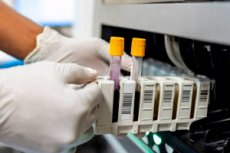New publications
New blood test for stroke detection combines biomarkers with clinical assessment
Last reviewed: 02.07.2025

All iLive content is medically reviewed or fact checked to ensure as much factual accuracy as possible.
We have strict sourcing guidelines and only link to reputable media sites, academic research institutions and, whenever possible, medically peer reviewed studies. Note that the numbers in parentheses ([1], [2], etc.) are clickable links to these studies.
If you feel that any of our content is inaccurate, out-of-date, or otherwise questionable, please select it and press Ctrl + Enter.

Stroke is the leading cause of disability and the second leading cause of death worldwide, but timely intervention can prevent serious consequences. A new study by researchers at Brigham and Women’s Hospital and colleagues describes the development of a new test that combines blood biomarkers with clinical assessment to accurately identify patients experiencing large vessel occlusion (LVO) stroke.
The results are published in the journal Stroke: Vascular and Interventional Neurology.
"We have developed a revolutionary, accessible tool that can help ensure that more people suffering from stroke are in the right place at the right time to receive critical, life-saving care," said lead author Joshua Burnstock, MD, Ph.D., MPH, a clinical fellow in the Department of Neurological Surgery at Brigham and Women's Hospital.
Most strokes are ischemic, in which blood flow to the brain is blocked. LVO strokes are an aggressive type of ischemic stroke that occurs when a blockage occurs in a major artery in the brain. When the blood supply to the brain is cut off, the lack of oxygen and nutrients causes brain cells to die within minutes. LVO strokes are serious medical emergencies and require urgent treatment using mechanical thrombectomy, a surgical procedure that removes the blockage.
"Mechanical thrombectomy has allowed people who would otherwise die or become significantly disabled to fully recover, as if the stroke had never happened," Burnstock said. "The earlier this intervention is performed, the better the outcome for the patient. This exciting new technology has the potential to allow more people around the world to receive this treatment sooner."
Previously, the research team targeted two specific proteins found in capillary blood: one called glial fibrillary acidic protein (GFAP), which is also associated with brain hemorrhages and traumatic brain injury; and another called D-dimer.
In this study, they showed that blood levels of these biomarkers, combined with the FAST-ED assessment for on-site stroke triage, could identify LVO ischemic strokes while ruling out other conditions such as cerebral hemorrhages. Hemorrhages cause similar symptoms to LVO strokes, making them difficult to distinguish in the field, although the treatment for each is significantly different.
In this prospective observational study of diagnostic accuracy, the researchers examined data from a cohort of 323 patients admitted with a stroke code in Florida between May 2021 and August 2022. They found that combining GFAP and D-dimer biomarker levels with FAST-ED data less than six hours from symptom onset allowed the test to detect LVO strokes with 93% specificity and 81% sensitivity. Other findings included that the test excluded all patients with intracerebral hemorrhages, signaling that the technology could be used to detect intracerebral hemorrhages in the field as well.
Burnstock’s team also sees promising future use of this affordable diagnostic tool in low- and middle-income countries, where advanced imaging is not always available. It could also be useful in assessing patients with traumatic brain injury. They are next conducting another prospective trial to measure the effectiveness of the test when used in the ambulance. They have also developed an interventional trial that uses the technology to speed up the triage of stroke patients, allowing them to bypass standard imaging and go straight to intervention.
"In stroke treatment, time is money," Burnstock said. "The quicker a patient gets on the right treatment path, the better their outcome. Whether that means ruling out a hemorrhage or confirming something needs intervention, being able to do that in the prehospital setting with the technology we've developed will be truly transformative."
